Awash with symbolic meanings, explore six biblical water narratives that foster deeper understanding of transformation and spiritual rebirth.
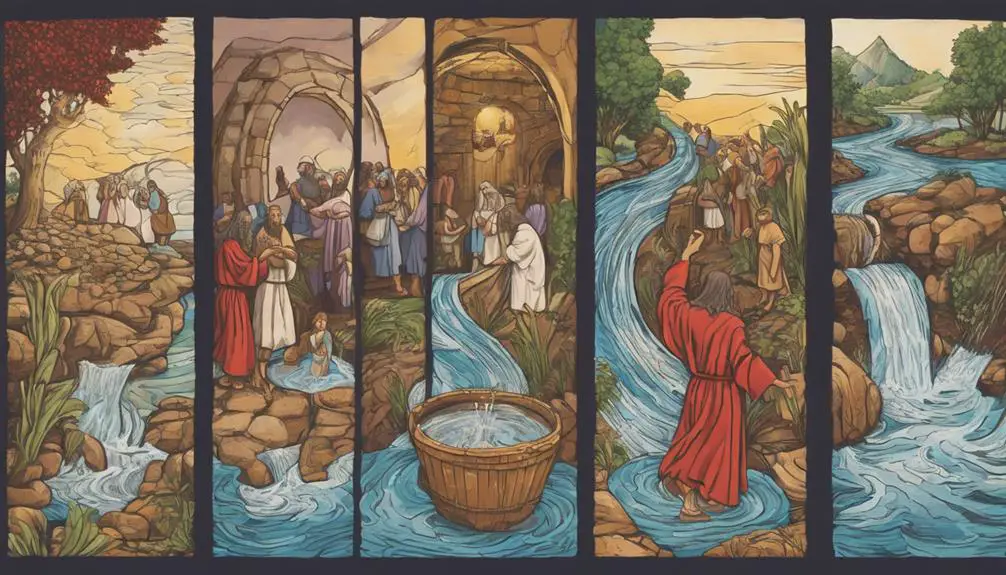
Six Examples of Water Stories in the Bible
Water, often seen as a symbol of purification, rebirth, and transformation, takes center stage in numerous narratives within the Bible. You've likely heard of the parting of the Red Sea, Jesus walking on water, or the story of Noah's Ark, but have you ever considered the deeper, symbolic meaning behind these tales?
Could there be more to these stories than their literal interpretation? As we dive into these six water stories from the Bible, you may be surprised at what truths and insights lie beneath the surface. Stay tuned, because we're just getting started.
Key Takeaways
- Water stories in the Bible signify divine power, transition, and spiritual renewal, as seen in miracles like parting of the Red Sea.
- Through water narratives such as Noah's Ark, the Bible illustrates God's judgment, mercy, and promise of a fresh start.
- Water's symbolism extends to Jesus's miracles, including turning water into wine and walking on the sea, demonstrating faith and transformation.
- The Bible uses water as a symbol of life and renewal, with Jesus's baptism in the Jordan River marking a spiritual transformation and His divine mission.
The Parting of the Red Sea

Diving into the Old Testament, you'll find an awe-inspiring tale of the parting of the Red Sea, a miraculous event orchestrated by God to deliver the Israelites from the clutches of Egyptian enslavement. This tale serves as one of the most powerful miraculous crossings in biblical history. As you recall the narrative, Moses, under God's command, stretched out his staff over the sea, causing the waters to part and forming a dry path for the Israelites to cross.
The Red Sea symbolism here goes beyond the mere physical crossing; it represents a spiritual journey from bondage to freedom. The water, often seen as a symbol of chaos and fear, was tamed by divine intervention, underlining the omnipotence of God. The Red Sea, in this context, also symbolizes a boundary, a barrier that God can miraculously remove when it serves His divine purpose.
In essence, the parting of the Red Sea serves as a testament to God's power and providence, offering hope and faith to believers. It's a tale of liberation and divine intervention, a miraculous crossing that signifies the triumph of faith over fear, and God's unyielding protection of His chosen people.
Noah's Ark and the Great Flood

Another monumental water story in the Bible is that of Noah's Ark and the Great Flood, where God's power and judgment are demonstrated through an act of divine purification. God instructed Noah to build an ark, signifying the start of the Ark's construction. Noah diligently crafted the ark, following God's precise specifications. This ark would serve as a refuge for Noah's family and a pair of every animal species.
After the ark's construction, the heavens opened and rain fell for forty days and nights, culminating in the Great Flood. The aftermath of the Flood was a world cleansed of wickedness, with Noah's family and the saved animals as its new inhabitants.
To help you grasp the key points of this dramatic event, consider the following table:
Event |
Description |
Significance |
|---|---|---|
Ark construction |
Noah builds an ark following God's instructions |
Marks God's intention to save Noah and animal species |
The Great Flood |
Rain falls for 40 days and nights |
Demonstrates God's power and judgment |
Flood aftermath |
The world is cleansed and repopulated |
Symbolizes a fresh start and divine purification |
Understanding Noah's Ark and the Great Flood deepens our comprehension of God's power, judgment, and mercy.
Moses Strikes the Rock
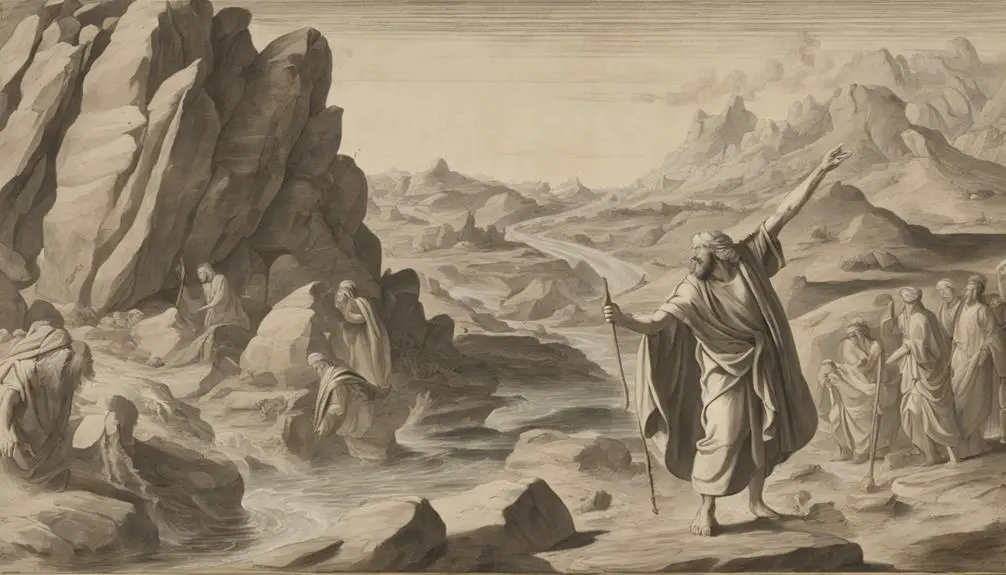
Moving forward in our exploration of biblical water narratives, let's now turn our attention to the story of 'Moses Strikes the Rock'. This story, found in Numbers 20:1-13, is quite significant, both for its rock symbolism and for the leadership challenges it presents.
In the narrative, the people of Israel are without water, and Moses, under God's direction, is told to speak to a rock. Instead, he strikes it twice with his staff, causing water to pour out. In this scenario, the rock is symbolic of God's provision and power. Moses' action of striking, rather than speaking to the rock, can be seen as a demonstration of disobedience and a lack of faith in God's word.
This story also highlights the challenges faced by Moses as a leader. The pressure from the complaining Israelites, coupled with his own frustrations, led Moses to act impulsively rather than obeying God's command. His actions resulted in severe consequences – he was denied entry into the Promised Land.
In this narrative, we see a clear illustration of how leadership challenges can lead to mistakes, and how disobedience to God's command, even in stressful situations, can have severe repercussions.
Jesus Turns Water Into Wine
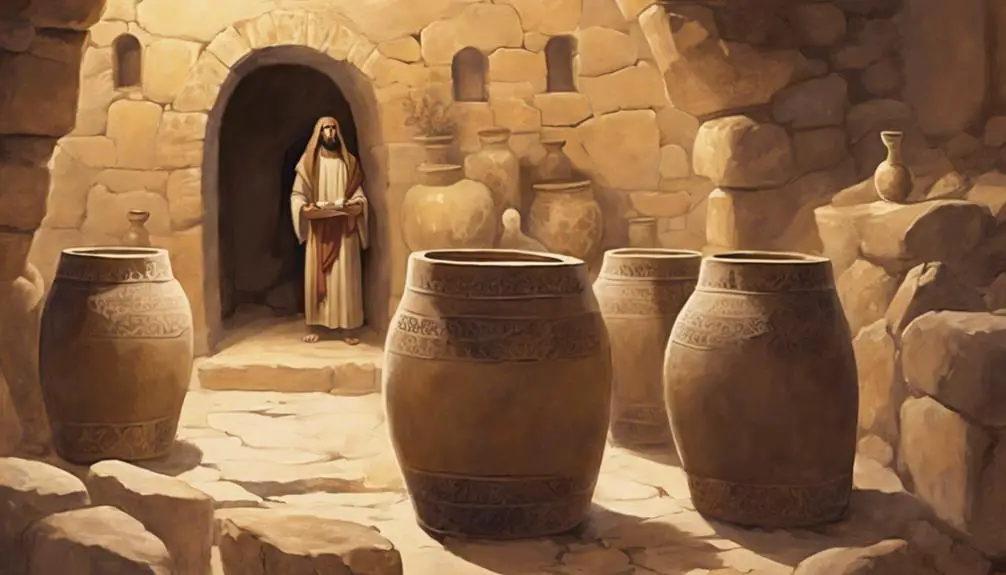
Let's turn our focus to the first miracle of Jesus recorded in the Bible – the transformation of water into wine at the Cana wedding, a profound narrative that not only showcases Jesus's divine power but also symbolizes the new covenant of grace. This miraculous transformation, as described in John 2:1-11, reflects a deeper symbolic interpretation.
In this account, Jesus instructs the servants to fill six stone jars with water, which he then turns into high-quality wine. This act wasn't merely a display of supernatural capability. It's an allegorical representation of Jesus's mission to bring spiritual renewal.
The conversion of water, a basic necessity for life, into wine, a symbol of joy and festivity, signifies the transformation of old religious practices into a new, vibrant faith. It's a metaphor for how Jesus's teachings would replace the old covenant with a new one, distinguished by grace and truth. The six stone jars represent the six days of creation, hinting at a new creation through Jesus.
Understanding this story, you'll appreciate the depth of symbolism in the Bible's water stories. Each narrative isn't just a historical account but a tapestry of profound spiritual truths.
Jesus Walks on the Sea

Delving deeper into our exploration of biblical water stories, you'll find the awe-inspiring account of Jesus walking on the sea – a powerful demonstration of His authority over nature and a profound metaphor resonating with spiritual insight. This story, found in Matthew 14:22-33, begins with Jesus' disciples in a boat, battered by waves and wind.
Suddenly, Jesus appears, walking towards them on the water, defying the natural laws with divine intervention. Initially, they're terrified, thinking they're seeing a ghost. But, it's Jesus, demonstrating the supernatural, encapsulating the essence of miraculous faith.
This event isn't just about Jesus' power over physical elements. It's also a lesson in faith. When Peter, one of the disciples, tries to walk towards Jesus on the water, he begins to sink, overcome by fear and doubt. Yet, when he cries out to Jesus, he's immediately saved, underlining the principle that faith, even as small as a mustard seed, can move mountains, or in this case, walk on water.
This narrative underscores the idea that, with faith in divine power, fear and doubt lose their grip, allowing you to tread where you'd otherwise sink.
The Samaritan Woman at the Well
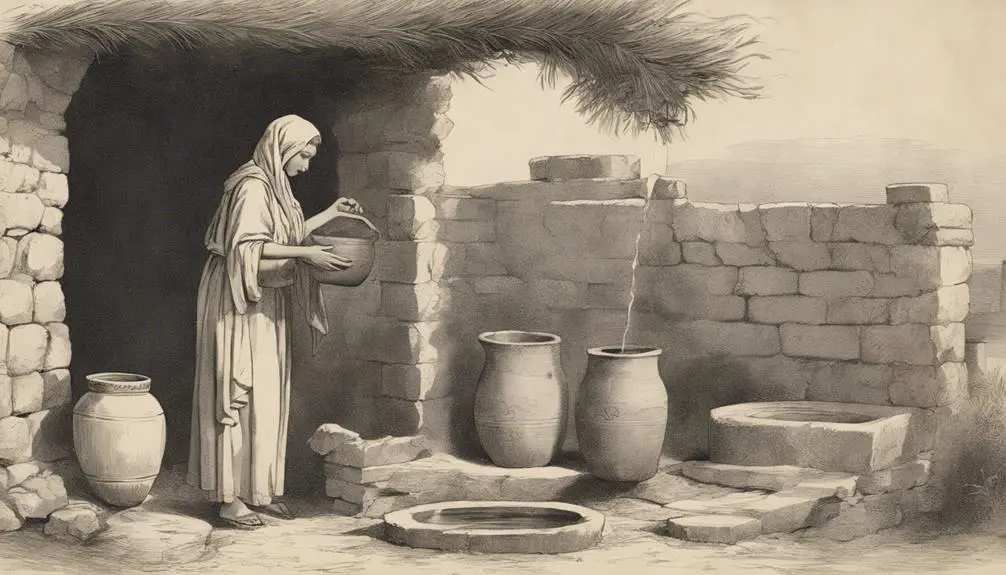
In the heart of the biblical narrative, nestled within the pages of John 4:4-26, you'll encounter the poignant tale of the Samaritan woman at the well. This story beautifully illustrates Jesus's capacity for transcending societal norms and offering spiritual enlightenment.
Here, Jesus, a Jew, initiates a conversation with a woman of Samaritan identity, blatantly ignoring the cultural barriers of his time. Jews and Samaritans were typically at odds, yet Jesus uses the common element of water to bridge this divide, showing his disregard for societal prejudices. The well becomes a meeting point for spiritual transformation, a testament to Jesus's universal message of love and acceptance.
When the Samaritan woman initially resists, Jesus doesn't turn away. Instead, he reveals his knowledge of her past, demonstrating his divine insight. This revelation prompts her to recognize him as the Messiah, a significant shift in her spiritual perspective.
This narrative demonstrates Jesus's ability to transcend cultural barriers to spread his message and how he used water as a metaphor for the life-giving spiritual sustenance he offered. It's a compelling reminder of the transformative power of faith, regardless of societal norms or individual backgrounds.
Jesus's Baptism in the Jordan River
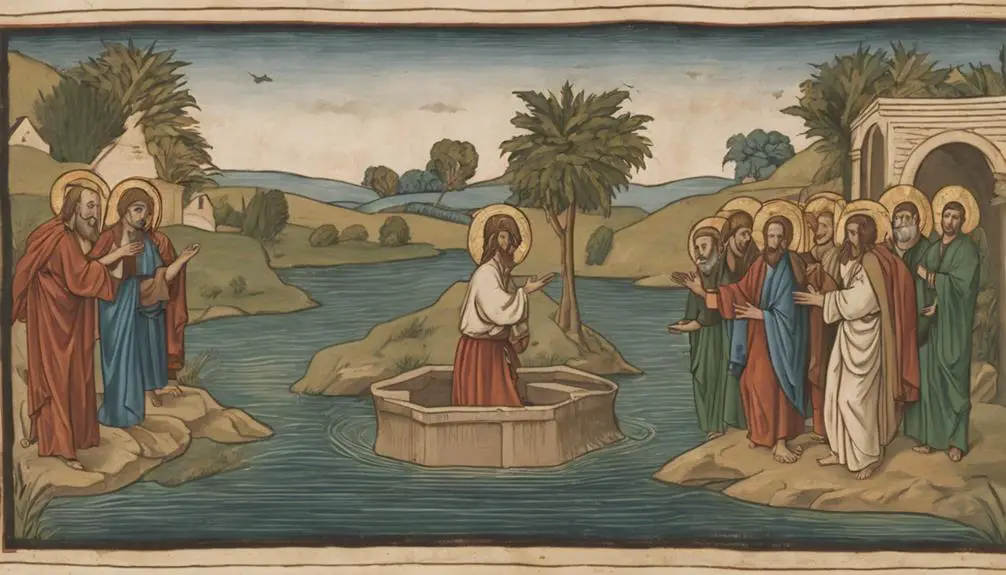
Venturing further into the biblical narratives, you encounter another pivotal moment that involves water: Jesus's baptism by John the Baptist in the Jordan River. The Jordan's significance here is multi-faceted. It's not just a physical location, but a symbol of transition, purification, and spiritual renewal.
The event isn't merely a ritualistic act but it's imbued with profound baptism symbolism. For Jesus, this baptism was a public declaration of His mission, an affirmation of His divine identity, and a foreshadowing of His sacrificial death and triumphant resurrection.
John the Baptist's role is also noteworthy. He's the prophesied forerunner, preparing the way for Jesus. His baptism of Jesus marks the passing of the Old Testament era and the inauguration of the New Testament age. It's a dramatic shift in God's redemptive plan.
The water of the Jordan River, in this context, signifies cleansing and transformation. It's a powerful image of the spiritual washing and renewal that believers experience in Christ. Thus, Jesus's baptism in the Jordan River is a profound event, layered with rich symbolism and theological insights. It's a pivotal water story in the Bible that continues to inspire and instruct believers today.
Frequently Asked Questions
What Is the Significance of Water in Other Religious Texts Outside the Bible?
In other religious texts, water holds profound significance too. For instance, water symbolism in the Quran represents life, knowledge, and purification. It's even seen as a divine blessing.
Similarly, in Hinduism, water is viewed as sacred and purifying. It's central to rituals, symbolizing life's flow and the cleansing of the soul.
Thus, water's significance transcends the Bible, highlighting universal themes of life, purity, and spirituality.
Can Any of These Water-Related Biblical Events Be Supported by Archaeological or Historical Evidence?
Yes, some of these water-based biblical events have potential archaeological support. For instance, the Biblical flood evidence, often linked to the Epic of Gilgamesh, has been backed by several archaeological discoveries. These discoveries suggest a massive flood event in the ancient Near East.
However, it's crucial to remember that correlation doesn't confirm causation, and these findings are subject to interpretation. It's a fascinating topic that merits ongoing research.
Are There Any Common Symbolic Meanings for Water in These Bible Stories?
In these narratives, you'll often notice water's duality, symbolizing both life and destruction. It's cleansing in the context of baptism symbolism, representing spiritual rebirth and purification.
However, it can also represent chaos, as seen in the Flood story. It's not just a physical element in these stories, but a versatile symbol carrying deep spiritual and emotional meanings.
This duality can be seen in many water-related biblical stories and parables.
How Have These Water Stories Been Interpreted Differently by Various Christian Denominations?
Different Christian denominations interpret biblical water stories in varied ways, reflecting their unique theological perspectives.
For instance, Catholics might view water as a symbol of cleansing and rebirth, linking it to baptism.
Meanwhile, Protestants might emphasize its life-giving properties, reflecting God's provision.
These interpretations aren't fixed, they can change or overlap, highlighting the rich complexity of biblical water symbolism.
It's fascinating how denominational perspectives can influence interpretation.
How Have These Water Stories Influenced Christian Art and Literature Throughout History?
You'll find that water stories have greatly influenced Christian art and literature. Artistic depictions often utilize water symbolism, painting scenes of baptism or the parting of the Red Sea.
Literary references are evident in hymns, poems, and novels, using water as metaphors for cleansing, rebirth, or divine intervention.
The impact is significant, revealing how these narratives have shaped Christian artistic and literary traditions over centuries.
Conclusion
Each of these biblical water stories has profound significance. They depict water as a symbol of transformation, judgement, provision, and revelation.
From the miraculous parting of the Red Sea to Jesus's baptism in the Jordan River, water takes a central role. It's a powerful conduit for God's messages and miracles, reminding us of His might, mercy, and mysterious ways.
So next time you read these stories, remember, they're not just tales—they're deep spiritual lessons.



Sign up